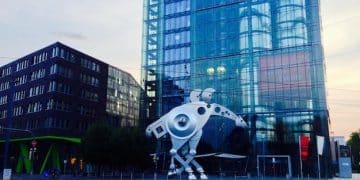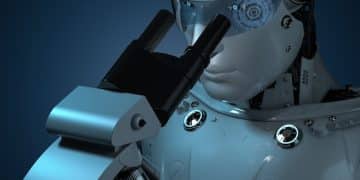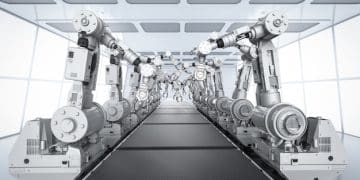AI Automation Reshaping US Tech Jobs: 2025 Skills Gap

The rapid ascent of artificial intelligence and automation is profoundly transforming the landscape of US tech jobs, necessitating a critical analysis of the impending skills gap by 2025 to ensure workforce readiness and enable strategic adaptation.
The tech industry is a dynamic force, constantly evolving, and at present, few phenomena are driving as much transformative change as artificial intelligence (AI) and automation. The question of how AI-powered automation is reshaping US tech job roles: a 2025 skills gap analysis is not merely academic; it’s a pressing concern for professionals, educators, and policymakers alike.
The Automation Imperative: Why AI is Disrupting Tech Jobs
The integration of AI and automation into various industries, particularly the tech sector, is no longer a futuristic concept but a present reality. This shift is driven by the unparalleled efficiency, scalability, and analytical capabilities that AI systems offer, fundamentally altering the nature of work. Understanding this imperative is crucial for anticipating future workforce demands.
Efficiency and Scalability Through AI
AI systems excel at automating repetitive, rule-based tasks with incredible speed and accuracy. This capability allows businesses to achieve higher operational efficiency and scale their operations without a proportional increase in human resources. From data entry and customer service chatbots to software testing and infrastructure management, AI is streamlining processes across the tech spectrum.
- Automated code generation and testing reduce development cycles.
- Predictive maintenance driven by AI optimizes hardware lifespan and uptime.
- Customer support bots handle routine queries, freeing human agents for complex issues.
- Data processing and analysis become faster and more accurate with AI algorithms.
The Economic Imperative for Adoption
Beyond efficiency, there’s a strong economic motivation for companies to adopt AI and automation. Lower operational costs, increased productivity, and the ability to process vast amounts of data for better decision-making provide a significant competitive advantage. As more companies embrace these technologies, the pressure mounts on others to follow suit, creating a ripple effect across the industry. This collective adoption inevitably reshapes job functions, demanding new skill sets from the workforce.
The implications for US tech jobs are clear. While some roles may be augmented or even made redundant, new opportunities requiring different, often higher-level, cognitive and creative skills are emerging. Navigating this transition requires foresight and proactive measures to equip the workforce with the competencies needed for the evolving landscape.
Emerging Job Roles and Shifting Priorities in a Post-Automation World
The common misconception is that AI automation solely eliminates jobs. While some tasks are certainly being automated, the more nuanced reality is the emergence of entirely new job roles and a significant shift in the priorities of existing ones. This transformation calls for a re-evaluation of educational pathways and professional development.
The Rise of AI-Centric Positions
With AI becoming foundational to many tech operations, there’s an increasing demand for professionals who can design, implement, and maintain these complex systems. These roles often require a blend of programming expertise, statistical analysis, and domain-specific knowledge. The job market is already reflecting this trend, with a surge in positions related to machine learning and data science.
- AI Ethics Officer: Ensuring AI systems are fair, transparent, and unbiased.
- Prompt Engineer: Crafting effective inputs to guide generative AI models.
- AI Solutions Architect: Designing and integrating AI systems into larger organizational infrastructures.
Augmentation, Not Just Automation
Many existing tech jobs are not being replaced but rather augmented by AI tools. Software developers might use AI-powered coding assistants, cybersecurity analysts might leverage AI for threat detection, and IT support professionals might use AI diagnostics. This augmentation shifts the focus of these roles from routine tasks to more strategic, oversight, and problem-solving activities. The emphasis moves from “doing” to “managing” and “innovating.” It’s about leveraging AI to achieve higher levels of productivity and insight, allowing human workers to concentrate on uniquely human capabilities like complex problem-solving, critical thinking, creativity, and emotional intelligence.
The key takeaway is that the demand is shifting towards roles that complement AI capabilities. This means fostering skills that AI cannot easily replicate, such as advanced analytical reasoning, complex communication, and interdisciplinary collaboration.
The Impending Skills Gap: What US Tech Professionals Need by 2025
As AI-powered automation continues its trajectory, the US tech industry faces a significant skills gap by 2025. This gap isn’t just about what skills are needed, but also about the pace at which the workforce can acquire them. Identifying these crucial competencies is the first step toward bridging this divide and ensuring a competitive workforce.

Technical Skills in High Demand
The foundational shifts driven by AI necessitate a strong grasp of new technical proficiencies. While traditional programming skills remain relevant, they are increasingly complemented by specialized knowledge in AI and data science. This includes understanding machine learning algorithms, deep learning frameworks, and data pipeline management. Cybersecurity skills, particularly in the context of AI systems, are also becoming paramount, as AI introduces new vectors for attacks. Cloud computing expertise remains vital, as most AI applications run on cloud infrastructure.
- Proficiency in machine learning frameworks (e.g., TensorFlow, PyTorch).
- Understanding of big data technologies (e.g., Hadoop, Spark).
- Expertise in cloud platforms (e.g., AWS, Azure, Google Cloud).
- Strong grasp of cybersecurity principles applied to AI systems.
Crucial Soft Skills for the AI Era
Perhaps even more critical than technical skills are the soft skills that leverage human capabilities beyond automation. As routine tasks are automated, the value of uniquely human attributes — such as critical thinking, creativity, problem-solving, and emotional intelligence — grows exponentially. Professionals will need to collaborate effectively with AI systems, interpret their outputs, and make strategic decisions based on data-driven insights. The ability to adapt to rapid technological changes and continuously learn is also non-negotiable.
Empathy, communication, and ethical reasoning are also paramount, especially as AI systems are deployed in sensitive areas like healthcare and finance. The interplay between human and machine intelligence will define the next generation of tech innovation and require a nuanced set of human-centric skills that AI cannot replicate.
Strategies for Bridging the Skills Gap: Education, Upskilling, and Reskilling
Addressing the emerging skills gap in the US tech sector requires a multi-pronged approach involving re-evaluating educational paradigms, promoting continuous upskilling initiatives, and facilitating reskilling programs for those whose roles are most impacted by automation. Proactive measures are key to ensuring workforce resilience and adaptability.
Reforming Educational Curricula
Traditional educational institutions, from universities to vocational schools, must adapt their curricula to meet the demands of the AI-driven economy. This involves integrating AI, machine learning, and data science concepts across various disciplines, not just computer science. Emphasis should be placed on project-based learning and interdisciplinary studies that foster critical thinking, problem-solving, and collaboration—skills essential for working alongside AI. Partnerships between academia and industry can ensure that educational programs are aligned with real-world needs and technologies.
Corporate Upskilling and Reskilling Programs
Companies bear a significant responsibility in preparing their current workforce for future roles. This translates into robust internal training programs focused on upskilling existing employees with new AI-relevant technical competencies and reskilling others for entirely new positions. Investing in continuous learning platforms, offering certifications, and even establishing internal academies can facilitate this transition. Such initiatives not only address the skills gap but also contribute to employee retention and engagement by demonstrating a commitment to their professional growth.
Governmental and Non-Profit Initiatives
Beyond individual companies, governmental bodies and non-profit organizations play a vital role in creating a supportive ecosystem for workforce development. This includes funding for training programs, developing national skills roadmaps, and providing incentives for businesses to invest in their employees’ future. Public-private partnerships can leverage resources effectively to scale up these initiatives, reaching a wider segment of the population. The goal is to create a culture of lifelong learning, where acquiring new skills is not just a corporate mandate but a societal norm, ensuring that the US tech workforce remains globally competitive.
Ethical Considerations and Societal Impact of AI in Tech Employment
The widespread adoption of AI and automation in the tech industry raises profound ethical considerations and societal impacts that extend beyond mere job displacement. Addressing these issues proactively is essential to ensure a just and equitable transition into an AI-powered future, mitigating potential negative consequences for individuals and society at large.
Algorithmic Bias and Fairness
One of the most critical ethical concerns revolves around algorithmic bias. AI systems are trained on vast datasets, and if these datasets reflect existing societal biases (e.g., in hiring practices, loan approvals, or legal judgments), the AI can perpetuate and even amplify these biases. This can lead to discriminatory outcomes in employment, disproportionately affecting certain demographic groups and exacerbating existing inequalities within the tech workforce. Ensuring fairness requires meticulous data curation, rigorous testing, and the development of ethical AI principles. It’s imperative that developers recognize and mitigate these biases to prevent systemic discrimination.
Data Privacy and Security
The increased reliance on AI means that more sensitive data is being collected, processed, and analyzed. This intensifies concerns about data privacy and security. AI systems need access to vast amounts of information to learn and perform effectively, raising questions about how this data is stored, who has access to it, and how it is protected from breaches. The potential for misuse of personal and professional data necessitates strong regulatory frameworks, robust cybersecurity measures, and a commitment from tech companies to prioritize user privacy. The integration of AI must not come at the cost of individual rights and data protection.
The Digital Divide and Inclusivity
As AI creates new high-skill jobs, there’s a risk of widening the digital divide. Those who lack access to necessary education, training, or technology could be left behind, creating a more stratified workforce. Ensuring inclusivity means developing accessible upskilling and reskilling programs, providing resources for underserved communities, and promoting diverse representation in AI development and leadership roles. The goal should be a future where the benefits of AI are broadly distributed, rather than concentrated among a select few. Ignoring these ethical and societal dimensions would not only lead to social unrest but also stifle innovation and limit the full potential of AI. Proactive dialogue and policy-making are crucial to navigate these complex challenges.
Anticipating 2025: Key Predictions for the US Tech Job Landscape
As we look towards 2025, several key predictions emerge regarding the evolution of the US tech job landscape under the influence of AI-powered automation. These forecasts suggest a continued acceleration of current trends, requiring proactive adaptation from both individuals and organizations to thrive in the changing environment.
Increased Specialization and Niche Roles
The broad category of “software developer” or “IT specialist” will likely give way to highly specialized roles. As AI automates generalized tasks, human expertise will be valued for its deep knowledge in specific areas. We can expect a proliferation of niche roles such as AI model auditing, explainable AI (XAI) engineering, quantum computing specialists, and bio-AI integrators. Professionals with interdisciplinary skills, combining deep tech knowledge with expertise in fields like psychology, ethics, or biology, will be particularly sought after. This demands a shift from broad skill sets to focused, intricate competencies.
The Rise of Human-AI Collaboration
By 2025, collaborative work between humans and AI systems will become the norm across most tech roles. This isn’t just about using AI as a tool, but about a more synergistic partnership where AI handles data processing and pattern recognition, while humans focus on creative problem-solving, strategic thinking, and ethical oversight. For instance, designers might use generative AI to brainstorm concepts, then refine and implement them. Marketers will leverage AI for predictive analytics, but human intuition will still be key for campaign strategy and emotional resonance. The ability to effectively “dialogue” with AI, understanding its strengths and limitations, will be a defining skill.

Continuous Learning as a Career Constant
The rapid pace of AI advancements means that skills acquired today may become obsolete much faster than in previous decades. Therefore, continuous learning (“reskilling-as-a-service”) will transition from a desirable trait to a career imperative. Tech professionals will need to constantly update their knowledge, whether through online courses, professional certifications, or on-the-job training. Companies that foster a culture of continuous learning and provide accessible resources will be better positioned to retain talent and remain competitive. The emphasis shifts from static qualifications to dynamic adaptability, making lifelong learning an intrinsic part of a tech career. This constant evolution will redefine professional longevity and growth.
The Role of Policy and Regulation in Shaping the Future of Work
The profound shifts brought about by AI in the US tech job market cannot be managed by market forces alone. The proactive involvement of policy and regulation is crucial to ensuring a fair, equitable, and stable transition, mitigating risks while maximizing the benefits of technological progress for all.
Investing in Workforce Development
Government policies must prioritize significant investment in workforce development programs. This includes funding for accessible education and vocational training that aligns with the evolving demands of the AI economy. Policies could offer tax incentives for companies that invest heavily in upskilling and reskilling their employees, or grants for educational institutions to develop cutting-edge AI-focused curricula. Beyond technical skills, promoting digital literacy widely is essential to ensure that no segment of the population is left behind in an increasingly automated world. These investments are critical to ensure a skilled populace for the jobs of tomorrow.
Establishing Ethical AI Guidelines and Standards
The ethical implications of AI, suchating the future of work within the tech industry. As a journalist covering these profound shifts, I can affirm that the narrative is not one of simple displacement, but rather a complex evolution where new roles emerge, existing ones transform, and the very fabric of how we work is redefined. The imperative for continuous adaptation and strategic foresight has never been more pressing for individuals and institutions alike.
Regulating Data Privacy and Algorithmic Fairness
Strong regulatory frameworks are needed to govern data privacy and ensure algorithmic fairness. This includes legislation akin to GDPR or CCPA that protects individual data rights, coupled with regulations specifically targeting algorithmic bias. Policies could mandate transparency requirements for AI systems used in critical functions like hiring, lending, or healthcare, allowing for auditing and accountability. Establishing independent bodies to oversee AI ethics and implementation could also play a vital role in ensuring that AI development adheres to societal values and prevents discriminatory outcomes.
Supporting Workers Through Transition
As some jobs are automated, policies must also focus on supporting workers through the transition. This could involve enhanced unemployment benefits, robust career counseling services, and portable benefits that are not tied to a specific employer. Exploring pilots for universal basic income or other social safety nets could become necessary discussions as the scope of automation grows. The goal is to create a robust social infrastructure that cushions the impact of rapid technological change, ensuring economic stability and promoting a just transition for all affected individuals. Without thoughtful policy, the benefits of AI could exacerbate societal inequalities and create widespread instability.
| Key Prediction | Brief Description |
|---|---|
| 🚀 Increased Specialization | Tech roles will become highly niche, requiring deep expertise in specific AI sub-fields and interdisciplinary skills. |
| 🤝 Human-AI Collaboration | Synergistic partnerships between humans and AI will be standard, with AI handling data and humans focusing on creativity and strategy. |
| 📚 Continuous Learning | Lifelong learning will be a career constant due to rapid AI advancements, necessitating ongoing skill updates. |
| ⚖️ Policy & Regulation Impact | Government policies and ethical guidelines will play a vital role in workforce development, data ethics, and worker support. |
Frequently Asked Questions
▼
AI is transforming software development by automating repetitive coding tasks, debugging, and testing. This frees developers to focus on higher-level problem-solving, architectural design, and innovation. New roles like MLOps engineers and AI integration specialists are emerging, while existing developers need to upskill in AI frameworks, prompt engineering, and ethical AI development to effectively leverage these new tools and maintain relevancy in the evolving landscape.
▼
While AI automation will undoubtedly change many job functions, experts largely predict a shift in roles rather than mass displacement by 2025. Routine and repetitive tasks are most at risk of automation, but new jobs requiring human-specific skills like creativity, critical thinking, ethical reasoning, and complex problem-solving are emerging. The key is adaptation and proactive reskilling rather than widespread job loss.
▼
In an AI-driven environment, critical thinking, complex problem-solving, creativity, emotional intelligence, and interpersonal communication are paramount. These “human-centric” skills enable collaboration with AI systems, interpretation of AI outputs, and the application of insights to strategic decision-making. Adaptability, continuous learning, and ethical reasoning are also vital for navigating the rapidly evolving technological landscape effectively.
▼
Educational institutions should integrate AI, machine learning, and data science across various curricula, not just computer science programs. Emphasizing project-based learning, interdisciplinary studies, and developing critical thinking alongside technical skills is crucial. Partnerships with industry can ensure that educational content remains relevant to real-world demands. Fostering a mindset of lifelong learning is also key, as the pace of technological change necessitates continuous skill acquisition.
▼
Government policy plays a crucial role by investing in workforce development programs, funding education and reskilling initiatives, and offering incentives for companies to train employees. Establishing ethical AI guidelines, regulating data privacy, and ensuring algorithmic fairness are also essential. Furthermore, policies that support workers transitioning between roles and address potential social safety net needs will be vital for a just and equitable future.
Conclusion
The transformative impact of AI-powered automation on US tech job roles by 2025 is undeniable, presenting both significant challenges and unparalleled opportunities. Navigating this landscape successfully hinges on a proactive and collaborative effort across individuals, educational institutions, businesses, and policymakers. By prioritizing continuous learning, fostering adaptability, and addressing ethical considerations, the US tech sector can not only bridge the impending skills gap but also lead the world in responsible and innovative AI integration, ensuring a future where technology empowers human potential.





